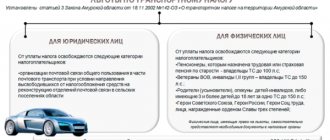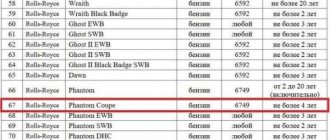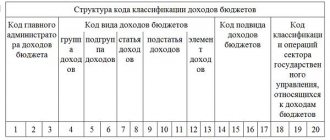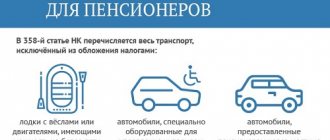From the name of the tax levy it is clear that it is paid by companies that own vehicles. This is a local, regional tax, and it is the local authorities who set the appropriate rate for it. All vehicle owners – both individuals and legal entities – must pay the duty on time. Chapter No. 28 of the Tax Code of the Russian Federation contains all the rules regarding the payment of transport fees. In the article we will tell you how to calculate transport tax for legal entities, coefficients, deadlines within which money must be transferred, and so on.
Transport tax for legal entities
Who should pay transport tax?
Payers of transport tax are companies where vehicles are registered. That is, taxes are paid by companies that have a car or other vehicle registered with the State Traffic Inspectorate. The obligation to transfer money to the state treasury remains in any case, even if the machine is not used for the direct needs of the company and does not generate income.
Typically, the tax is calculated on cars and trucks, as well as buses that are on the company’s balance sheet. But if a company has a specific type of activity, it will also pay a fee for another type of transport, for example, water transport. A yacht club that owns boats, cutters and yachts and offers them for rent has an obligation to the state to pay a fee.
We emphasize that only companies that own vehicles pay the fee. If a vehicle fleet is rented and construction equipment is leased, the obligation to pay the transport fee rests with the owner of the vehicles or equipment.
Incurrence of tax obligations
If your organization owns a car, then it is recognized as a transport tax payer. Obligations to pay tax arise at the moment when information about the owner organization is entered into the registration documents for the car.
Your company is a tax payer not only in cases where a passenger or freight transport vehicle is registered to the company. Also, the company will have to pay tax if the company owns water or air transport, be it a yacht, motor boat, boat, airplane or helicopter.
Note that the tax must be paid not only to companies that own cars, but also to companies participating in leasing agreements. This is possible in the following cases:
- An organization purchases a car, registering ownership of it. When concluding a leasing agreement and transferring the car to the lessee, the vehicle is re-registered to the user (lessee). When returned, the car is again registered to the lessor. In this situation, the lessee pays the tax during the period of use of the car according to the term of the agreement, the lessor - from the moment of registration until the transfer of the lease, as well as after the expiration of the leasing agreement;
- When purchasing a vehicle, the lessor company immediately registers it in the name of the lessee, so tax obligations immediately arise for the organization that actually uses the vehicle. When returning a car from leasing, the car is registered in the name of the lessor, after which this organization pays the tax. This scheme is used quite rarely in practice and only in cases where a company buys a car directly for rent to a specific organization (person).
How to calculate and pay?
Compared to individuals who, at the end of the annual tax period, receive a notification about the need to pay the transport fee and its amount, legal entities are required to independently calculate the amount to be paid. The calculations made are included in the declaration, which must be submitted to the inspectorate at the place of registration of the LLC. Documents documenting transport fee reporting from legal entities are accepted by the inspectorate no later than the first February working day of the year following the reporting year. The tax, as we have already said, is local, which means that regional authorities can provide for the payment of preliminary (advance) payments. They are paid to the treasury quarterly, but there is no need to submit a declaration on them to the inspectorate.
Just like for ordinary citizens, for legal entities the transport tax is calculated using a simple formula: the tax base multiplied by the rate. Let's figure out where to get these indicators from. The rate is set for a specific type of transport according to an important criterion - the power of its engine. The amount of tax is directly related to this indicator - the more powerful the transport, the higher the rate on it, and the higher the tax. The engine power is found out in an elementary way - it is indicated in the vehicle passport (PTS).
The rate is not fixed for the entire country - each region has the right to change the value, making it less or more. But local authorities are somewhat limited in this matter, since they do not have the right to increase or decrease the rate by more than ten times compared to the federal one. To find out at what rate the tax is calculated in a particular subject of the country, just go online or contact the tax office.
Increase or decrease factors can be added to the calculation formula. The increasing coefficient (Kp) applies to expensive cars, the price of which is more than three million rubles. The coefficient also depends on the period of use of the car after its release - the older the “elite” car, the less the tax will increase.
Table of coefficients increasing transport tax
For more information about transport tax and how to calculate it, read our article.
Calculation of transport tax for legal entities
We have already figured out that companies must calculate the amount of the fee themselves, without waiting for the Federal Tax Service to require them to submit a declaration. For each vehicle owned by the company, the tax is calculated separately. There are four things you need to know:
- tax rate;
- engine power;
- the time that the company owns the transport;
- whether it is necessary to apply reduction or increase factors.
Table 1. Examples of transport tax calculation
| Example No. 1 | Example No. 2 | Example No. 3 |
| Krug LLC owns a 2015 BMW car with an engine power of one hundred and two horsepower. The car cost one and a half million, so there is no need to apply an increase factor. The LLC operates in Sverdlovsk, where the rate for 2021 is 9.4 rubles. Accordingly, when multiplying the engine power by the rate, the annual tax amount is 958.8 rubles. According to tax rules, the figure will be rounded to 959. | purchases a Mercedes car from the showroom in March 2021, the power of which is one hundred and forty horsepower. This is a new car, its price is 3.2 million rubles, for this reason the increase factor comes into force. The company also operates in Sverdlovsk, where the authorities have approved a transport tax rate of 9.4 rubles. Thus, the tax for 2021 (do not forget that the car was purchased in March) will be 1,645 rubles. Therefore, a company that owns a vehicle for less than a full year must determine a coefficient for calculating the tax fee. To do this, you need to divide the number of months in which the company owns the vehicle by the number of months in the tax period - 12. This is called the “Q coefficient”. | If Triangle LLC owns a Mercedes for ten months, then the coefficient Kw will be 0.83. |
Video - Calculate and pay transport tax on a car
Calculation of preliminary payments
To calculate the advance quarterly tax payment, you need to use the formula specified in Article No. 362 of the Tax Code of the Russian Federation. It looks like this:
Tax base x tax rate x coefficient KP (if any) x coefficient Kv / 4 (number of quarters per year).
Let's look at an example. Moscow LLC "Kvadrat" is calculating an advance payment for a Honda car worth six hundred thousand rubles and a capacity of one hundred and twenty-five horsepower.
Since the Kp coefficient is not applicable, and the transport tax rate for Moscow is 25 rubles, the formula looks like this: (125 x 25 x 1) / 4 = 781 rubles.
Will it be canceled or not?
The fate of the transport tax for legal entities and individuals has been hotly debated in society and authorities over the past few years. The following alternatives are offered:
1. Increase in excise taxes on gasoline. Thus, those who travel more will pay more. On the one hand, the option is not bad, but then it will also lead to an increase in the price of goods, the price of which includes transportation costs.
2. Tax calculation based on the vehicle’s environmental friendliness. Then you will have to pay more to low-income owners of old cars, which is not entirely fair.
Be that as it may, the tax is in effect in 2021; the proposed bills have not yet received support.
Deadlines for payment of transport fees
Regional authorities have the right to independently set the terms within which transport owners will transfer payments. But, according to Chapter No. 362 of the Tax Code of the Russian Federation, this deadline cannot be set earlier than the first working day of February (most often this is the first day of the month). Advance payments, as we have already figured out, are due quarterly. But upfront payments are not required for regional installations. If the authorities do not require payment of the tax four times a year, then the entire amount is paid in one lump sum.
LLCs owning heavy trucks may qualify for benefits
Examples
LLC purchased a truck with a capacity of two hundred and ten kilowatts. The base was calculated in this way: 210 kW multiplied by 1.35962 and the result was 285.52 liters. With.
The total for such equipment was 8.5 rubles per unit of power.
The tax amount was:
285.52 l. With. × 8.5 rub./l. With. = 2426.92 rub.
The company owned one unit of cargo equipment with a capacity of 155 horsepower. The rate for this category of vehicles is 38 rubles per horsepower.
The amount was calculated as follows:
155 l. With. multiplied by 38 rub./l. With. The result was 5890 rubles.
What online calculators are it convenient to do this on?
To calculate the amount of tax on a car, you can use calculators that are posted on Internet sites. For example, you can use this https://www.nalog.ru/rn77/service/calc_transport/ Internet resource or this https://calcs.su/html/calcs/transportnii-nalog.html.
The principle of using any online calculator is the same . You must enter:
- information about the region of location;
- car make and model;
- year of manufacture;
- engine power.
After this, the system will produce the desired result.
Transport fee: changes
Since the beginning of 2021, a number of changes have occurred in Russia regarding the payment of vehicle tax for LLCs:
- According to Chapter No. 362 of the Tax Code of the Russian Federation, the list of expensive cars posted on the website of the Ministry of Industry and Trade applies only to the period in which it is posted. There is no need to recalculate the amount of the fee for previous years.
- The procedure for calculating the ownership coefficient (Kv) has been clarified according to the information we provided above (full months of ownership to the number of months in a year). Now a full month is considered to be the one when the vehicle was purchased before the fifteenth day or deregistered after the fifteenth day.
- A tax deduction has appeared for heavy vehicles, the amount of which is equal to payments for damage caused to roads by heavy vehicles. Thus, the tax levy for “heavy cargo” can be reduced completely, to zero.
List of passenger cars with an average cost of 3 million rubles for the 2021 tax period
Increasing coefficients for expensive cars
For expensive cars that cost more than 3 million rubles, the tax is calculated with an increasing factor.
The Ministry of Industry and Trade publishes a list of such cars every year on its website before March 1. Separate coefficients are established for different price ranges:
From 3 to 5 million rubles. — coefficient 1.1, if the year of manufacture is no more than 3 years old;
From 5 to 10 million rubles. – coefficient 2 if no more than 5 years have passed since the year of manufacture.
From 10 to 15 million rubles. – coefficient 3 if no more than 10 years have passed
Over 15 million rubles. – coefficient 3 if no more than 20 years have passed.
For example, the AudiQ7 quattro car is on the list of the Ministry of Industry and Trade for 2021 in the category of cars with an average cost of 3 to 5 million rubles. This means that the tax for it must be calculated with an increasing factor of 1.1.
Declaration
The document that reflects all the information about the payment of such amounts is a tax return. It must be filled out according to the rules approved by current legislation and sent to the Federal Tax Service at established intervals.
Due dates
The deadline for submitting the declaration is determined by Article 363.1 of the Tax Code of the Russian Federation . This document must be submitted no later than February 1 of the year following the reporting year. If the due date falls on a weekend, the due date is moved to the next working day.
The declaration of advance payments for transport tax is not submitted.
Recommendations for filling
When preparing a document, you should be guided by the requirements of Order of the Federal Tax Service of Russia dated December 5, 2021 No. ММВ-7-21 / [email protected] “On approval of the form and format for submitting a tax return for transport tax in electronic form and the procedure for filling it out.” The specified normative act approved a document form that must be used without fail. Therefore, it is impossible to draw up a declaration arbitrarily.
When filling out the form, you must enter all data carefully, without making mistakes . Otherwise, the declaration will not be accepted. The document must have an electronic signature of the manager, which confirms its authenticity.
Privileges
Article 358 of the Tax Code of the Russian Federation defines a list of equipment in respect of which the owner does not pay taxes. It includes:
- boats that require oars to move;
- motorboats with an engine power of no more than 5 liters. With.;
- Vehicles with an engine up to 100 liters. With.;
- means of river and sea navigation engaged in fishing;
- river, sea and air transport that transport people and goods;
- special vehicles for agricultural purposes;
- cars that are listed on the balance sheet of federal authorities;
- wanted equipment;
- air ambulance;
- drilling rigs and platforms for oil production.
Payment on the territory of Moscow
In Moscow and the Moscow region, rules differ from other regions of the country.
To find out how to correctly calculate transport tax, let’s look at some of the rules in force in Moscow in relation to legal entities that are registered in this territory:
- Transport tax without making an advance payment must be paid no later than February 5.
- The tax amount must be in full rubles. To do this, the digital result is simply rounded to a whole number, if the result is 50 kopecks. and more.
- All excess charges will be included in the next payment for transport or can be returned by the tax service to the company’s account.
Such rules are coordinated by the Tax Law for Moscow, adopted on July 9, 2008.
Benefits in Moscow are provided only to those legal entities that carry out cargo and passenger transportation, except for taxis.







